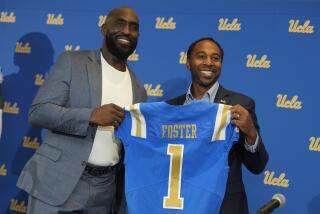Athletic Officials at CSUN Pledge Not to Give Up : Finances: Hiegert vows to bring the funding referendum, which failed by 87 votes, to the ballot box again next fall.
- Share via
NORTHRIDGE — Athletic administrators at Cal State Northridge have altered an age-old rallying cry in the wake of a failed attempt to secure additional funding for the school’s sports programs.
“Wait till next year” has become instead, “Wait till next semester.”
A proposed fee increase for athletics was narrowly rejected in a vote by Northridge students this week, but Athletic Director Bob Hiegert pledged Thursday that similar legislation will be on the ballot again next fall. If a fee increase is not passed, the school faces the loss of its football program, Hiegert said.
“We’re going to come back with another referendum and we’re going to get it passed,” Hiegert said.
The measure failed, 993-906, although it passed, 892-875, among students polled at Northridge. Swinging the vote were results tabulated from the school’s satellite campus in Ventura, where the proposal lost by a 118-14 count.
“Next time we need to send our team to that campus,” said women’s volleyball Coach Lian Kang Lu, who had his players canvassing Northridge polling areas. “I’ll drive them in my car.”
The proposal called for fee increases of $6 per semester beginning in the fall and growing to $40 by the fall of 1998.
Also failing, and by a far more lopsided margin, was a proposal to change the Northridge nickname. Only 392 votes were cast for a switch from Matadors to Quakes, a name that proponents argued would help the school capitalize on the Jan. 17 earthquake from a marketing standpoint.
Voting to retain the nickname were 1,334 students, and 172 voted to change to another, unspecified nickname.
Athletic officials had anticipated a close vote on the fee increase proposal. Last month, Judith Brame, Northridge’s associate athletic director, challenged Northridge coaches to “play this one like it’s a championship game” at a meeting during which the proposal was unveiled.
Several coaches took the advice to heart.
Softball and football players were required to vote before they were allowed to practice. As a result, the start of Northridge’s first spring football workout was delayed more than an hour.
The future of football at Northridge hangs precariously in the balance as athletic officials begin to review their strategy for a second attempt.
Gender-equity requirements that call for schools in the Cal State system to reach funding and participation parity in men’s and women’s sports by the 1998-99 school year have left Northridge officials playing catch-up in a lopsided numbers game.
With additional funding, Northridge planned to add soccer and at least one other sport to its list of offerings for women. Without more money, Hiegert said, the school might be forced to slash its largest and most expensive men’s program--football--to reach compliance.
Under terms of an agreement reached in October between the CSU system and the California chapter of the National Organization for Women, the 19 CSU campuses with NCAA athletic programs must:
* Provide athletic opportunities for women proportional to the number of NCAA-eligible female undergraduates on each campus, within 5%.
* Provide scholarships for women’s sports in proportion to the number of eligible female undergraduates on each campus, within 5%.
* Fund men’s and women’s sports programs within 10% of each other.
Currently, about 65% of Northridge athletes are men, and male sports teams account for roughly 60% of the athletic program’s budget for salaries, operations and scholarships.
Under the school’s 1992-93 athletic budget, the elimination of football would have placed Northridge within the agreed funding guidelines and almost qualifying in terms of participation.
“It doesn’t take a rocket scientist to figure it out,” Hiegert said. “Your resources wind up dictating your participation numbers. If you don’t have the resources, you end up taking people off the field.”
Similar dilemmas have forced the demise of football programs at Cal State Long Beach, Cal State Fullerton and Cal State Hayward.
Hayward announced the elimination of its football program earlier this year after students rejected a proposed fee increase similar to the one at Northridge.
Students at Cal Poly San Luis Obispo, San Francisco State and Chico State have passed fee increases for athletics in recent years. However, none of those campuses faced a series of economic blows comparable to those absorbed by Northridge in the past year.
“The last five years in the state system have been ugly,” said Gary Torgeson, the softball coach, “and here it’s been worse because the earthquake left a lot of students around here out of work. Now is not exactly the best time to be asking for more money.”
However, at least one factor--a small voter turnout--seemed to favor athletics.
“As a department, we were relying on apathy,” one coach said. “If you put ballots in people’s hands (the proposal) goes down in flames. It’s not even close.”
Men’s volleyball Coach John Price said the key for a second successful attempt will be voter education.
“If you get a referendum on the ballot that says, ‘Do you want your fees increased?’ you’re going to get a lot of no votes,” he said. “We need to get people out explaining the issue so the students can make an informed choice. If they understand it, they’ll vote for it.”
Lu, who came to Northridge from UC Santa Barbara, advised school administrators to be persistent in their push for a fee increase. An athletics fee at Santa Barbara was rejected four times before it passed last year.
“If you have good organization, you will win,” Lu said. “‘Failure is the foundation for success. When you fail, you learn.”
More to Read
Get our high school sports newsletter
Prep Rally is devoted to the SoCal high school sports experience, bringing you scores, stories and a behind-the-scenes look at what makes prep sports so popular.
You may occasionally receive promotional content from the Los Angeles Times.







